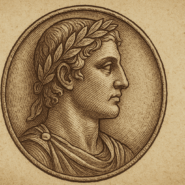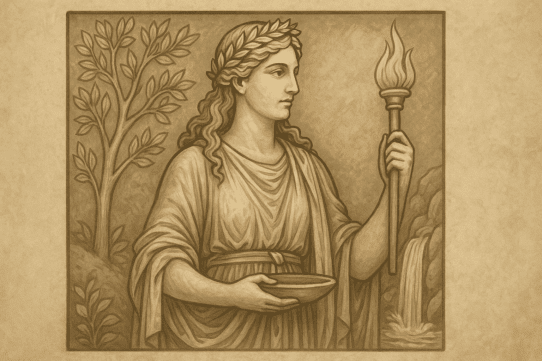Concordia stands as one of Rome’s most reassuring divine figures: the embodiment of harmony, balance, and unity.
In a civilization constantly negotiating political rivalries, social tensions, and the responsibilities of empire, Concordia offered a sacred ideal that Romans could aspire to. She represented the possibility that families could remain unified, that the Senate could function without discord, and that the state could endure through cooperation rather than division.
Her presence persisted for centuries across temples, coins, festivals, and state ceremonies. Where other goddesses ruled domains such as love, war, or the hearth, Concordia ruled the delicate but essential space between people. She was the quiet, stabilizing force that held the Roman world together.
Origins And Meaning
The name “Concordia” comes from the Latin con (together) and cor (heart), reflecting the idea of “hearts together.” From early Roman religion onward, Concordia symbolized the internal strength of a united community. This unity was both personal and political. She was invoked to settle disputes, heal divisions, and bring agreement where conflict threatened stability.
Her earliest cult dates to the fourth century BCE, during a period of class tension between patricians and plebeians. Rome’s leaders dedicated her first temple on the Capitol to signal reconciliation and renewed cooperation. From that moment on, Concordia became a key figure whenever Rome sought peace within itself.
Concordia In Public Life And Politics
No goddess was more intertwined with Rome’s political landscape. The Senate frequently invoked Concordia during moments of unrest, civil conflict, or transition of power. Temples to her stood near the Senate House and other civic centers, serving as reminders that collective unity was the foundation of Roman strength.
During the late Republic, when political factions battled for dominance, leaders often tried to associate themselves with her virtues. Coins bearing her image circulated widely, promoting messages of peace and collaboration even as tensions grew in the streets. Emperors later adopted her symbolism to reinforce the stability of their rule. A harmonious empire, guided by Concordia, was seen as a prosperous one.
The Iconography Of Concordia
Artists typically portrayed Concordia as a serene, matronly figure seated upon a throne. She frequently holds:
- A patera, or offering bowl, representing the rituals that bind the community together
- A cornucopia, symbolizing abundance brought about through unity
- A caduceus, the wand of peace
- Joined hands, a powerful emblem of agreement
Both Republican and Imperial coins depict these symbols, reinforcing her role as the patron of social balance. Through her imagery, Romans could instantly recognize the essential values she stood for: mutual respect, cooperation, and civic order.
Harmony Within The Household
While her political significance was widely celebrated, Concordia’s influence reached into the private sphere as well. Roman families invoked her to preserve unity between spouses, siblings, and generations. Domestic peace was considered foundational to the well-being of the state. A harmonious household produced stable citizens, and stable citizens made for a stable Rome.
Marriage, in particular, benefited from her blessings. Couples offered prayers to Concordia to ensure fidelity, trust, and the steady continuity of family life. Her symbolism even appeared in marriage ceremonies and domestic shrines.
Concordia And Other Roman Goddesses
Concordia formed an important conceptual trio with Pax, the goddess of peace, and Securitas, the goddess of security. Together, these deities represented the ideals of the Roman state during its most stable periods. While Pax governed peace itself, and Securitas ensured long-term protection, Concordia focused on the relationships and agreements that made both possible.
She also complemented Justitia (Justice) and Fides (Trust), creating a divine framework for Roman law, diplomacy, and societal ethics. Her presence demonstrated that Rome valued not only strength but cooperation.
The Legacy Of Concordia
Even after the fall of the Western Roman Empire, the symbolism of Concordia endured. Her name survives in modern institutions, mottos, and academic ideals centered on social harmony and collaboration. The concept of “concord” is still used to describe unity of purpose, mutual understanding, and peaceful coexistence.
In art and culture, she remains a reminder that harmony is not a passive state. It is something that must be nurtured, protected, and renewed—a lesson the Romans knew all too well.
Why Concordia Matters Today
Concordia’s story is more relevant now than ever. Her influence highlights the importance of cooperation during times of uncertainty. She represents:
- The strength found in shared purpose
- The power of reconciliation
- The value of community and family unity
Her message is timeless: lasting peace begins with harmony between individuals.
Concordia may not wield the thunderbolts of Jupiter or the fierce beauty of Venus, but she represents something equally essential. She is the quiet force that turns conflict into cooperation, division into solidarity, and uncertainty into stability.








